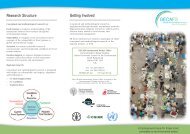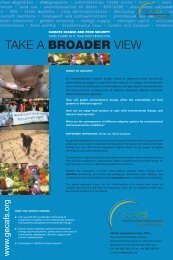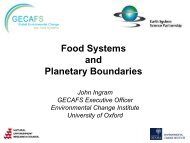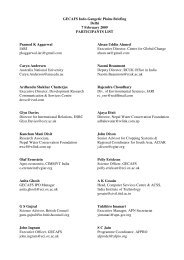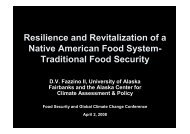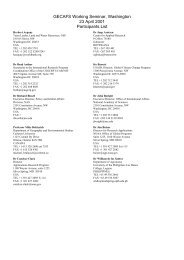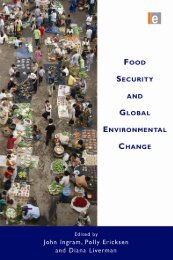From Food Production to Food Security - Global Environmental ...
From Food Production to Food Security - Global Environmental ...
From Food Production to Food Security - Global Environmental ...
- No tags were found...
Create successful ePaper yourself
Turn your PDF publications into a flip-book with our unique Google optimized e-Paper software.
development (Lee, 1999; Gunderson and Holling, 2002; Henrichs, 2006). Such approacheslay the foundations for delivering specific support for key policy-makers at the national andregional levels (as outlined by Lal et al., 2001). These approaches rely upon a strategy thatbegins with identifying the key stakeholders, includes a process of reflection <strong>to</strong> develop acommon understanding of the problem, and then proceeds through a joint learning process.But, and as noted above, designing such a strategy – let alone implementing it – is far fromstraightforward. A greater appreciation of such ideals will however help researchers andpolicy-makers work <strong>to</strong>gether so that the best available scientific information informs thepolicy process. Another way <strong>to</strong> think of decision support platforms is that they include a se<strong>to</strong>f <strong>to</strong>ols, methods and information that facilitates the dialogue among scientists and policymakersin a co-learning framework. This co-learning approach is central <strong>to</strong> the engagementand decision support process. Furthermore, this approach provides a strong basis for social,biophysical and economic scientists <strong>to</strong> learn how <strong>to</strong> effectively address complex issues in aholistic, practical setting.Innovative decision support platforms (such as the 'Questions and Decisions' (QnD) system:Kiker et al., 2005; Kiker and Linkov, 2006) will be needed for food security–GEC research asthey allow the incorporation of complex ecosystem models, and their linkage <strong>to</strong>environmental-based decision support <strong>to</strong>ols, in a systematic way. Other researchers haveplaced particular emphasis on trade-off analysis, integrating biophysical and socio-economicmodels in a process or dialogue with policy-makers (Antle et al., 2003; S<strong>to</strong>orvogel et al.,2004). Antle (2003) emphasizes that the approach is a ‘process’, not a model per se. The formof the model and analyses are guided through stakeholder dialogue, thereby helping regionalpolicy-makers and other stakeholders <strong>to</strong> understand and plan for impacts of GEC in thesocial, political and economic context in which decisions are made and policies areimplemented. Decision support platforms will be used within a decision support process thatcombines data processing and analysis, modelling, evaluation and assessment <strong>to</strong>ols, enhancedconcepts (e.g. vulnerability) and policy projections (national, regional and international). Thedecision support process will also use a range of dissemination mechanisms (e.g. policybriefs, printed maps). No single decision support system will fit the needs of all situations, soa flexible framework will be needed. The aim of the GECAFS decision support research hasbeen <strong>to</strong> develop approaches that will help policy-makers and other stakeholders in clear andeffective ways. The scenarios exercises were very effective components in this regard,primarily by facilitating communication and mutual understanding of the range ofstakeholders’ world views.Figure 3 shows how the various components of food systems research (i.e. on food systemsand their vulnerability <strong>to</strong> GEC; adaptation options; scenario construction; and trade-offanalyses) can be brought <strong>to</strong>gether in a structured dialogue between scientists andstakeholders. It also shows the critical aspect of joint agenda-setting.82



